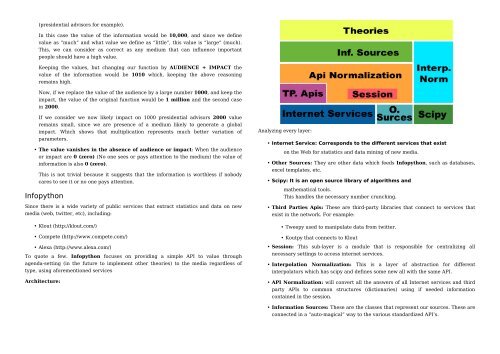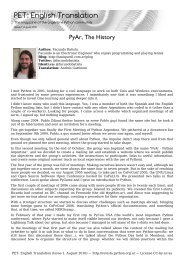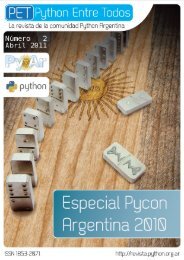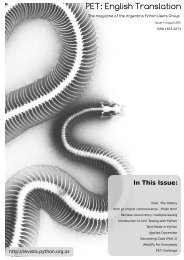color version - PET: Python Entre Todos - Python Argentina
color version - PET: Python Entre Todos - Python Argentina
color version - PET: Python Entre Todos - Python Argentina
You also want an ePaper? Increase the reach of your titles
YUMPU automatically turns print PDFs into web optimized ePapers that Google loves.
(presidential advisors for example).<br />
In this case the value of the information would be 10,000, and since we define<br />
value as “much” and what value we define as “little”, this value is “large” (much).<br />
This, we can consider as correct as any medium that can influence important<br />
people should have a high value.<br />
Keeping the values, but changing our function by AUDIENCE + IMPACT the<br />
value of the information would be 1010 which, keeping the above reasoning<br />
remains high.<br />
Now, if we replace the value of the audience by a large number 1000, and keep the<br />
impact, the value of the original function would be 1 million and the second case<br />
in 2000.<br />
If we consider we now likely impact on 1000 presidential advisors 2000 value<br />
remains small, since we are presence of a medium likely to generate a global<br />
impact. Which shows that multiplication represents much better variation of<br />
parameters.<br />
• The value vanishes in the absence of audience or impact: When the audience<br />
or impact are 0 (zero) (No one sees or pays attention to the medium) the value of<br />
information is also 0 (zero).<br />
This is not trivial because it suggests that the information is worthless if nobody<br />
cares to see it or no one pays attention.<br />
Infopython<br />
Since there is a wide variety of public services that extract statistics and data on new<br />
media (web, twitter, etc), including:<br />
• Klout (http://klout.com/)<br />
• Compete (http://www.compete.com/)<br />
• Alexa (http://www.alexa.com/)<br />
To quote a few. Infopython focuses on providing a simple API to value through<br />
agenda-setting (in the future to implement other theories) to the media regardless of<br />
type, using aforementioned services<br />
Architecture:<br />
Analyzing every layer:<br />
• Internet Service: Corresponds to the different services that exist<br />
on the Web for statistics and data mining of new media.<br />
• Other Sources: They are other data which feeds Infopython, such as databases,<br />
excel templates, etc.<br />
• Scipy: It is an open source library of algorithms and<br />
mathematical tools.<br />
This handles the necessary number crunching.<br />
• Third Parties Apis: These are third-party libraries that connect to services that<br />
exist in the network. For example:<br />
• Tweepy used to manipulate data from twitter.<br />
• Koutpy that connects to Klout<br />
• Session: This sub-layer is a module that is responsible for centralizing all<br />
necessary settings to access internet services.<br />
• Interpolation Normalization: This is a layer of abstraction for different<br />
interpolators which has scipy and defines some new all with the same API.<br />
• API Normalization: will convert all the answers of all Internet services and third<br />
party APIs to common structures (dictionaries) using if needed information<br />
contained in the session.<br />
• Information Sources: These are the classes that represent our sources. These are<br />
connected in a “auto-magical” way to the various standardized API’s.
















